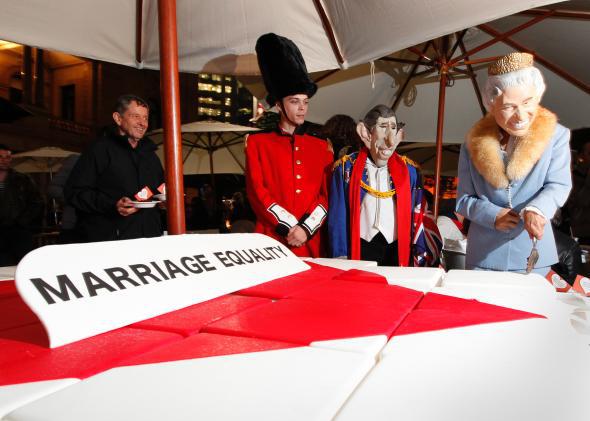Tucked away near the middle of the Supreme Court’s ruling in U.S. v. Windsor, in a part of the opinion only John Roberts read, Justice Anthony Kennedy puts forth the uncontroversial proposition that “same-sex marriages [were] made lawful by the unquestioned authority of the States.” It’s a relatively minor point, a gesture toward federalism in an opinion otherwise dominated by an encomium to personal liberty.
Still, as Australia reminds us today, we shouldn’t take our laboratories of democracy for granted quite yet. This week, Australia’s highest court struck down the equivalent of a state law allowing same-sex marriages in the Australian Capital Territory, holding that only the federal government can legalize such unions. Twenty-seven gay marriages were immediately annulled. (As one man put it, barely holding back tears: “We’ve been unmarried.”) The court hinged its logic on the highly questionable proposition that conflicting federal and territorial marriage laws would create statutory confusion—an argument rejected as facetious at best by the Windsor court. Australia tends to be a fairly enlightened country, yet the court’s anti-gay decision was unanimous. Gay marriage remains banned throughout the country. How did the United States beat Australia to the punch?
The answer lies in America’s somewhat odd federalist system. Progressives are used to seeing states use their limited sovereignty to constrict liberty, through voter ID laws, abortion restrictions, and other malicious legislation. It’s all too easy, then, to remember the obverse: American states have relatively free rein to experiment with new policies and ideas, within reasonable limit. Medical marijuana is, in many parts of the country, a standard form of care; before California legalized it in 1996, it was a joke. (Today, 20 states and Washington, D.C., have such programs.) Roe v. Wade has been criticized by liberals for short-circuiting the standard state-by-state process: At the time of the ruling in 1973, a number of blue states were feeling their way toward looser abortion laws, but the organic process was cut short by judicial mandate. And today, California and New Jersey are leading the way in banning ex-gay conversion “therapy,” a now-discredited practice that remained, until recently, terrifyingly widespread.
But no state-by-state campaign in American history has been as successful—or as reliant on a broad reading of states’ rights—as the marriage equality movement. When Vermont legalized civil unions in 2000, it was outré. When Massachusetts legalized gay marriage in 2003, it set off a firestorm of controversy. When Hawaii did the same last month, nobody blinked an eye. The slide to normalization took about a decade. In the whole of American history, that is simply unprecedented.
That’s the bright side of the system, one that equality-minded Australians will likely covet after this week’s surprising setback. But there’s a darker side, too. For all the states that have expanded gay rights within their borders, more have restricted them, or attempted to nullify them altogether. States can be both laboratories of democracy and breeding grounds of hatred. Thus far, the American gay rights movement has cautiously championed a states’ rights approach; all Windsor did, after all, was broaden the rights and responsibilities of married gay couples within equality states. But that chapter is quickly coming to a close, as marriage proponents shift their focus to the remaining holdouts and push the Supreme Court to invalidate the remaining bans on constitutional grounds.
The American gay marriage strategy—a state-by-state push, followed by an eventual federal mandate—is messy, tedious, and time-consuming. But it works. Meanwhile, in progressive Australia, not a single gay couple can obtain a certificate that declares them legally married. Wedding bells won’t ring until a strong majority of the entire country pushes through a gay marriage bill, a consummation devoutly to be wished but unlikely to be achieved, at least in the near future. When it does occur, there may still be a few American states holding out against the tide, but we’ll have had some form of marriage for years longer. Different systems, different strategies—and today, I wouldn’t trade our system for the world.
